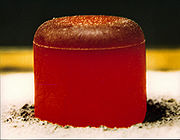
GPHS-RTG
Encyclopedia

General Purpose Heat Source
The General Purpose Heat Source is a radioactive heat source designed for Radioisotope Thermoelectric Generators or Stirling radioisotope generators . It is meant for space applications and is packaged as a stackable module.-Characteristics:...
Radioisotope Thermoelectric Generator. These are a specific American design of Radioisotope Thermoelectric Generator
Radioisotope thermoelectric generator
A radioisotope thermoelectric generator is an electrical generator that obtains its power from radioactive decay. In such a device, the heat released by the decay of a suitable radioactive material is converted into electricity by the Seebeck effect using an array of thermocouples.RTGs can be...
(RTG) used on space missions (e.g. Cassini-Huygens
Cassini-Huygens
Cassini–Huygens is a joint NASA/ESA/ASI spacecraft mission studying the planet Saturn and its many natural satellites since 2004. Launched in 1997 after nearly two decades of gestation, it includes a Saturn orbiter and an atmospheric probe/lander for the moon Titan, although it has also returned...
(x3), New Horizons
New Horizons
New Horizons is a NASA robotic spacecraft mission currently en route to the dwarf planet Pluto. It is expected to be the first spacecraft to fly by and study Pluto and its moons, Charon, Nix, Hydra and S/2011 P 1. Its estimated arrival date at the Pluto-Charon system is July 14th, 2015...
(x1), Galileo probe (x2), Ulysses probe
Ulysses probe
Ulysses is a decommissioned robotic space probe that was designed to study the Sun as a joint venture of NASA and the European Space Agency . The spacecraft was originally named Odysseus, because of its lengthy and indirect trajectory to near Solar distance...
(x1) ).
Each GPHS-RTG has a mass of about 57 kg and generates about 300 Watts of electrical power at the start of mission (from about 4,400 Watts of thermal energy) from about 7.8 kg of Pu-238
Plutonium-238
-External links:**...
based fuel.
The GPHS-RTG use SiGe thermoelectric elements which are no longer in production.
The thermoelectric elements convert the heat energy from the isotope into electricity. Missions after 2010 requiring RTGs, such as the Mars Science Laboratory
Mars Science Laboratory
The Mars Science Laboratory is a National Aeronautics and Space Administration mission with the aim to land and operate a rover named Curiosity on the surface of Mars. The MSL was launched November 26, 2011, at 10:02 EST and is scheduled to land on Mars at Gale Crater between August 6 and 20, 2012...
, will use the MMRTG instead. A future power source which also uses the GPHS is the Advanced Stirling Radioisotope Generator
Advanced Stirling Radioisotope Generator
The Advanced Stirling Radioisotope Generator is a radioisotope power system using Stirling power conversion technology currently being developed under joint sponsorship by the United States Department of Energy and NASA for potential future space missions...
, or ASRG.
The GPHS-RTG used on the Galileo, Ulysses, Cassini, and Pluto New Horizons missions were designed and built by General Electric Space Division (later part of Martin-Marietta, subsequently part of Lockheed Martin), in King of Prussia, Pennsylvania. Fueling of these generators was performed by Department of Energy laboratories in Miamisburg, Ohio and Idaho Falls, Idaho.
Note that the GPHS
General Purpose Heat Source
The General Purpose Heat Source is a radioactive heat source designed for Radioisotope Thermoelectric Generators or Stirling radioisotope generators . It is meant for space applications and is packaged as a stackable module.-Characteristics:...
are cuboid although they contain cylindrical Plutonium based pellets.



